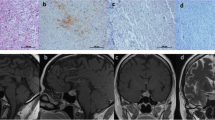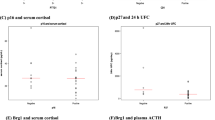Abstract
In recent years, the tissue inhibitor of metalloproteinase-3 (TIMP3) plays a pivotal role in tumorigenesis, while the role of TIMP3 in adrenocorticotrophic hormone (ACTH)-secreting pituitary adenomas remains unclear. In this study, 86 sporadic pituitary tumor specimens, including ACTH (40), GH (18), PRL-secreting (8), and non-functioining (20) and non-tumorous pituitary samples (n = 10) were available, and then, the mRNA and protein expression of TIMP3 was quantified by quantitative reverse transcriptase polymerase chain reaction (RT-PCR), western blotting, and immunohistochemistry, respectively. Our findings showed that TIMP3 expression was significantly correlated with Ki-67 expression and the invasiveness of pituitary adenomas. TIMP3 mRNA and protein expression were reduced in ACTH-secreting pituitary adenomas and the other three types of pituitary adenomas compared to adjacent non-tumorous pituitary tissues (all p < .01). On the other hand, the expression of TIMP3 was negatively correlated with tumor size and Ki-67 in ACTH-secreting pituitary adenomas. TIMP3 mRNA expression was significantly lower in invasive pituitary adenomas than that in noninvasive ones (1.92-fold, p < .05). TIMP3 protein levels were also significantly lower in the majority of invasive adenomas (1.41-fold, p < .05) Furthermore, TIMP3 mRNA and protein expression were significantly lower in pituitary giant adenomas than those in microadenomas (2.58-fold, p < .05). In conclusion, the expression of TIMP3 is low in pituitary adenomas including ACTH-secreting pituitary adenomas and negatively associated with tumor aggressiveness. TIMPs may play a potential role in the progression of ACTH-secreting pituitary adenomas and be useful as a biomarker of invasiveness.





Similar content being viewed by others
References
Anania MC, Sensi M, Radaelli E, Miranda C, Vizioli MG, Pagliardini S, Favini E, Cleris L, Supino R, Formelli F, Borrello MG, Pierotti MA, Greco A (2011) TIMP3 regulates migration, invasion and in vivo tumorigenicity of thyroid tumor cells. Oncogene 30(27):3011–3023
Barski D, Wolter M, Reifenberger G, Riemenschneider MJ (2010) Hypermethylation and transcriptional downregulation of the TIMP3 gene is associated with allelic loss on 22q12.3 and malignancy in meningiomas. Brain Pathol 20(3):623–631
Beaulieu E, Kachra Z, Mousseau N, Delbecchi L, Hardy J, Béliveau R (1999) Matrix metalloproteinases and their inhibitors in human pituitary tumors. Neurosurgery 45(6):1432–1440, 1440–1441
Catasus L, Pons C, Muñoz J, Espinosa I, Prat J (2013) Promoter hypermethylation contributes to TIMP3 down-regulation in high stage endometrioid endometrial carcinomas. Histopathology 62(4):632–641
Chetty C, Lakka SS, Bhoopathi P, Kunigal S, Geiss R, Rao JS (2008) Tissue inhibitor of metalloproteinase 3 suppresses tumor angiogenesis in matrix metalloproteinase 2-down-regulated lung cancer. Cancer Res 68(12):4736–4745
Cushing H (1932) The basophil adenomas of the pituitary body and their clinical manifestations (pituitary basophilism. Obes Res 1994 2(5):486–508
Darnton SJ, Hardie LJ, Muc RS, Wild CP, Casson AG (2005) Tissue inhibitor of metalloproteinase-3 (TIMP-3) gene is methylated in the development of esophageal adenocarcinoma: loss of expression correlates with poor prognosis. Int J Cancer 115(3):351–358
De Schutter H, Geeraerts H, Verbeken E, Nuyts S (2009) Promoter methylation of TIMP3 and CDH1 predicts better outcome in head and neck squamous cell carcinoma treated by radiotherapy only. Oncol Rep 21(2):507–513
Fox AJ, Schär MO, Wanivenhaus F, Chen T, Attia E, Binder NB, Otero M, Gilbert SL, Nguyen JT, Chaudhury S, Warren RF, Rodeo SA (2014) Fluoroquinolones impair tendon healing in a rat rotator cuff repair model: a preliminary study. Am J Sports Med 42(12):2851–2859
Jehle S, Walsh JE, Freda PU, Post KD (2008) Selective use of bilateral inferior petrosal sinus sampling in patients with adrenocorticotropin-dependent Cushing’s syndrome prior to transsphenoidal surgery. J Clin Endocrinol Metab 93(12):4624–4632
Kornfeld JW, Meder S, Wohlberg M, Friedrich RE, Rau T, Riethdorf L, Löning T, Pantel K, Riethdorf S (2011) Overexpression of TACE and TIMP3 mRNA in head and neck cancer: association with tumour development and progression. Br J Cancer 104(1):138–145
Lee MH, Atkinson S, Murphy G (2007) Identification of the extracellular matrix (ECM) binding motifs of tissue inhibitor of metalloproteinases (TIMP)-3 and effective transfer to TIMP-1. J Biol Chem 282(9):6887–6898
Mahller YY, Vaikunth SS, Ripberger MC, Baird WH, Saeki Y, Cancelas JA, Crombleholme TM, Cripe TP (2008) Tissue inhibitor of metalloproteinase-3 via oncolytic herpesvirus inhibits tumor growth and vascular progenitors. Cancer Res 68(4):1170–1179
Mampalam TJ, Tyrrell JB, Wilson CB (1988) Transsphenoidal microsurgery for Cushing disease. A report of 216 cases. Ann Intern Med 109(6):487–493
Nieuwesteeg MA, Walsh LA, Fox MA, Damjanovski S (2012) Domain specific overexpression of TIMP-2 and TIMP-3 reveals MMP-independent functions of TIMPs during Xenopus laevis development. Biochem Cell Biol 90(4):585–595
Pavloff N, Staskus PW, Kishnani NS, Hawkes SP (1992) A new inhibitor of metalloproteinases from chicken: ChIMP-3. A third member of the TIMP family. J Biol Chem 267(24):17321–17326
Petersenn S, Beckers A, Ferone D, van der Lely A, Bollerslev J, Boscaro M, Brue T, Bruzzi P, Casanueva FF, Chanson P, Colao A, Reincke M, Stalla G, Tsagarakis S (2015) Therapy of endocrine disease: outcomes in patients with Cushing’s disease undergoing transsphenoidal surgery: systematic review assessing criteria used to define remission and recurrence. Eur J Endocrinol 172(6):R227–R239
Qi JH, Ebrahem Q, Moore N, Murphy G, Claesson-Welsh L, Bond M, Baker A, Anand-Apte B (2003) A novel function for tissue inhibitor of metalloproteinases-3 (TIMP3): inhibition of angiogenesis by blockage of VEGF binding to VEGF receptor-2. Nat Med 9(4):407–415
Shen Y, Winkler IG, Barbier V, Sims NA, Hendy J, Lévesque JP (2010) Tissue inhibitor of metalloproteinase-3 (TIMP-3) regulates hematopoiesis and bone formation in vivo. PLoS One 5(9): pii: e13086.
Shinojima T, Yu Q, Huang SK, Li M, Mizuno R, Liu ET, Hoon DS, Lessard L (2012) Heterogeneous epigenetic regulation of TIMP3 in prostate cancer. Epigenetics 7(11):1279–1289
Smith E, De Young NJ, Tian ZQ, Caruso M, Ruszkiewicz AR, Liu JF, Jamieson GG, Drew PA (2008) Methylation of TIMP3 in esophageal squamous cell carcinoma. World J Gastroenterol 14(2):203–210
Yang Y, Sheng M, Huang F, Bu D, Liu X, Yao Y, Dai C, Sun B, Zhu J, Jiao Y, Wei Z, Zhu H, Lu L, Zhao Y, Jiang C, Wang R (2014) Downregulation of insulin-like growth factor binding protein 6 is associated with ACTH-secreting pituitary adenoma growth. Pituitary 17(6):505–513
Yu WH, Yu S, Meng Q, Brew K, Woessner JF Jr (2000) TIMP-3 binds to sulfated glycosaminoglycans of the extracellular matrix. J Biol Chem 275(40):31226–31232
Zerrouqi A, Pyrzynska B, Febbraio M, Brat DJ, Van Meir EG (2012) P14ARF inhibits human glioblastoma-induced angiogenesis by upregulating the expression of TIMP3. J Clin Invest 122(4):1283–1295
Acknowledgments
The authors thank Dr. Run Yu (Cedars-Sinai Medical Center, Los Angeles, CA) and Shunzeng Lv for the helpful discussion and editing of this manuscript.
Author information
Authors and Affiliations
Corresponding author
Ethics declarations
Conflict of Interest
The authors declare have no competing interests.
Ethics Approval
The study was approved by the Ethical Committee of Peking union medical college hospital, and all patients had written informed consent.
Additional information
Bowen Sun and Xiaohai Liu contributed equally to this work.
Rights and permissions
About this article
Cite this article
Sun, B., Liu, X., Yang, Y. et al. The Clinical Utility of TIMP3 Expression in ACTH-Secreting Pituitary Tumor. J Mol Neurosci 58, 137–144 (2016). https://doi.org/10.1007/s12031-015-0698-z
Received:
Accepted:
Published:
Issue Date:
DOI: https://doi.org/10.1007/s12031-015-0698-z




